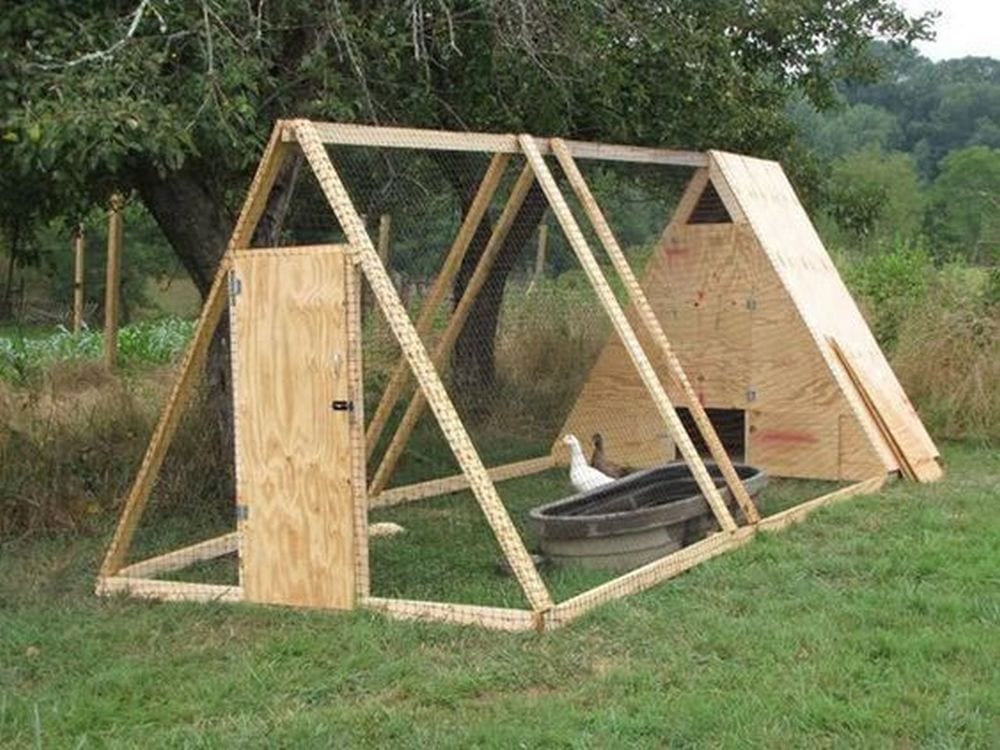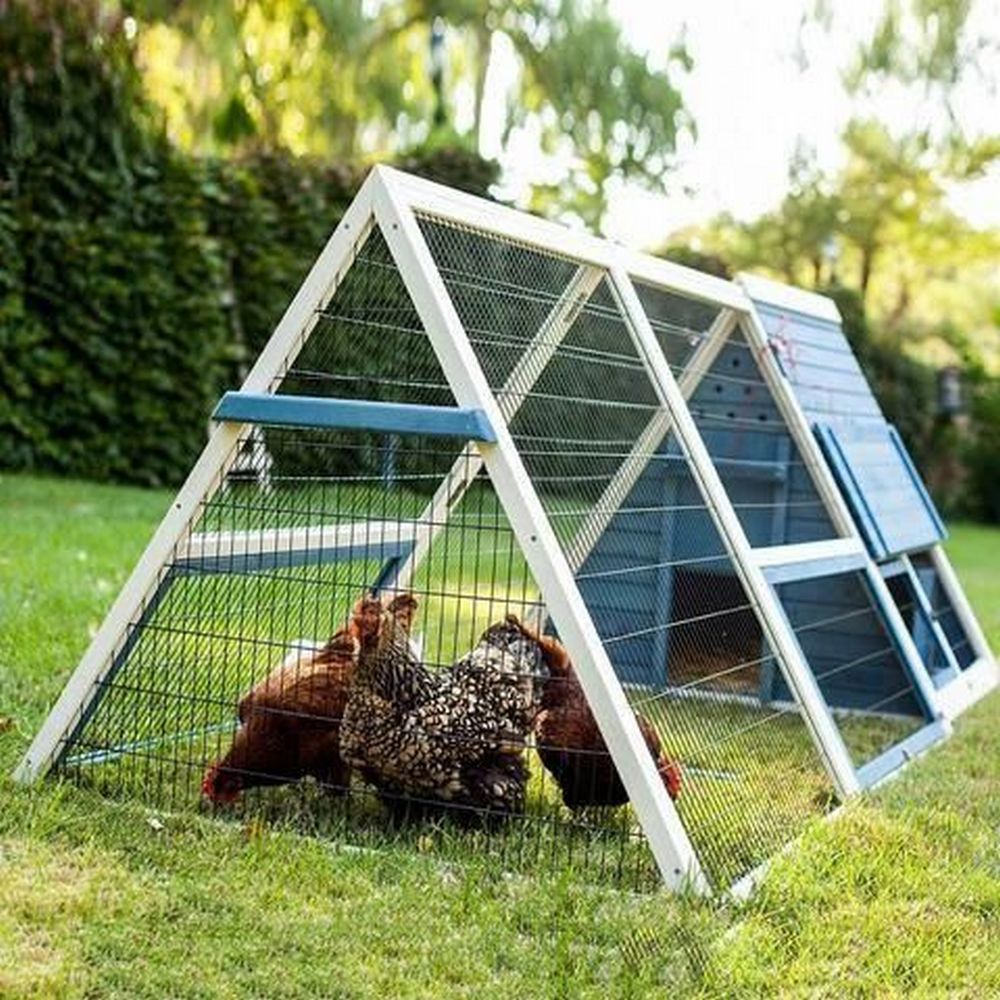Last Updated on May 7, 2024 by teamobn

This A-frame chicken coop greatly simplifies life!
This do-it-yourself project is an excellent alternative if you want a gorgeous yet cost-effective chicken coop. Chicken coops can be designed in a variety of styles.
With a cutting-edge coop design, you’ll have a stylish and practical place for your chickens to call home. Not only will this coop keep your birds safe and comfortable, but it’s also super easy to build YOURSELF – meaning you’ll save a bundle of cash.
A chicken coop is like a fortress that protects your precious flock from all kinds of dangers lurking out there. Plus, it’s a cool hangout spot that your chickens can call their own. Even if you have acres of area for your feathery friends to roam, a chicken coop is an essential accessory that will make their life safer and happier.

If you’re on the hunt for a chicken coop that’s as easy-breezy as a tropical vacation, then check out the A-frame! This sleek coop is like a superhero – it’s portable AND self-cleaning, which means you can say goodbye to those dreaded chicken poop scrubbing sessions.
Well, the first step to cluck-tastic success is sizing it up! From your personal preferences to the number of feathered friends you want to keep cozy, the dimensions of your A-frame chicken coop will make all the difference.

The last thing you want is a cramped coop for your feathered friends. Once you’ve got that squared away, it’s time to get creative and plan out the perfect dimensions for your coop.
Then, think of its walls. They are going to do double duty as both your coop’s walls AND roof, so they have to be tough. Don’t let your precious pets get caught in the rain or snow. Build a paradise with a perfect slope and towering walls to ensure their safety and comfort. Make sure to secure those walls, so your feathered friends can walk and move in leisurely under that roof.

When planning your A-frame chicken coop, be sure to consider the base. Attaching a 1-inch hardware cloth will help make your coop self-cleaning, as all chicken droppings and debris will fall through to the ground. This will make cleaning and maintenance much easier, and keep your chickens healthy and comfortable.
Would you also consider this A-frame chicken coop if you want to raise chickens in your backyard?
Contents
How to Build a DIY A-Frame Chicken Coop
Prepare to embark on a cluck-tastic adventure as we delve into the world of DIY craftsmanship and chicken care. This project promises to be more than just a coop; it’s a feathered haven, a symbol of self-sufficiency, and a testament to your dedication to providing your chooks with a cozy home.

Unfold the steps to creating an A-Frame chicken coop that’s not only functional but also stylishly unique. It’s time to take your feathery friends on a once-in-a-lifetime roosting experience, whether you’re a seasoned pro or just getting the hang of DIYs! Prepare to gather the necessary materials and tools for this one-of-a-kind project!
Materials
- 22 – 2×4″x8′ boards (studs)
- 2 – 2×8″x10′ – pressure-treated boards
- 2 – 2×8″x6′ – pressure-treated boards
- 1 – 1×6″x6′ – pressure-treated board
- 3 – 1×3″x8′ boards for trimming doors
- 3/4″ poultry net staples
- 3″ exterior screws
- 1-inch hardware cloth, 2 rolls
- 2 – 1.75-in W x 3.98-in L x 5/16-in Dia. Stainless Steel U-Bolt
Tools
- Drills
- Miter Saw
- Framing Wizard
- Hammer
- Multi-tool
Click on any image to start the lightbox display. Use your Esc key to close the lightbox.









Steps
Here are the steps for making a DIY A-frame chicken coop:
Step 1: Prepare Your Work Area
- Find a suitable location for your A-frame chicken coop and ensure it is level. Clear the area of any debris or obstacles that might interfere with construction.
Step 2: Build the A-Frame
- Begin by constructing the A-frame using the 2×4″x8′ boards. Cut four boards to your desired length for the base and top, making sure they are equal in size.
- Assemble the base by connecting two of the cut boards to create a triangle. Use 3″ exterior screws to secure them. Repeat this process for the top part of the A-frame.
- Connect the base and top sections with two 2×4″x8′ boards as diagonal supports, forming the A-frame structure.
Step 3: Add Roof Support
- Attach two 2×8″x10′ pressure-treated boards along the length of the A-frame as roof support beams. Secure them with screws.
Step 4: Roofing and Siding
- Cover the roof with the 2×8″x6′ pressure-treated boards, ensuring they overlap and are securely attached.
- Install the 1-inch hardware cloth on the sides and ends of the coop for ventilation. Use poultry net staples to secure it.
Step 5: Nesting Boxes
- Construct nesting boxes using the 1×6″x6′ pressure-treated board. Create individual compartments for your hens to lay eggs. Attach them to one side of the coop.
Step 6: Doors and Trim
- Use the 1×3″x8′ boards to frame the coop doors and windows. Install doors on both sides for easy access and cleaning.
Step 7: Finishing Touches
- Ensure all screws and fasteners are secure, and trim any excess wire or wood.
- Install the U-bolts to create perches inside the coop for your chickens to roost on.
Your A-Frame chicken coop is now complete! Remember to personalize it with paint, additional nesting materials, and bedding to make it a cozy and functional home for your chickens. Regularly clean and maintain the coop!
Additionally, a valuable tutorial video is available to provide you with a step-by-step visual guide from beginning to end. Once you’ve watched it, you’ll have the confidence and know-how to effortlessly construct your very own A-frame chicken coop.
Advanced Security Features for Predator Protection
When raising chickens, protecting them from predators is crucial. A well-secured A-frame chicken coop can be the difference between a safe flock and a vulnerable one. Predators like foxes, raccoons, and even birds of prey can pose significant threats to your chickens. Implementing advanced security measures can help you ensure the safety of your feathered friends.
Below are some enhanced security features to consider for your A-frame chicken coop.
Fortified Foundations and Floors
To prevent predators from digging under the walls, reinforce the base of your A-frame chicken coop. Installing a buried perimeter of hardware cloth that extends at least 12 inches below the surface can deter digging animals. For added protection, consider laying a complete floor made of hardware cloth or solid wood, which can prevent any creatures from burrowing into the coop.
Locking Mechanisms and Solid Doors
The entrances to your A-frame chicken coop should be secured with high-quality locks. Raccoons, known for their dexterity, can easily open simple latches. Use raccoon-proof locks or padlocks on all coop doors. Ensure that the doors fit snugly without gaps, as small openings can be an invitation for smaller predators.
Predator-Proof Roofing and Walls
Ensure that the roofing and walls of your A-frame chicken coop are robust and free from gaps or holes. Use heavy-duty materials such as thick wood, solid metal, or durable composites. Secure all joints and possible entry points with screws and predator-resistant fasteners. For additional safety, cover any windows or vents with strong wire mesh or hardware cloth.
Motion-Sensor Lighting
Installing motion-sensor lighting around your chicken coop can be an effective deterrent against nocturnal predators. These lights will startle and scare away many animals that might be scouting for a way into your coop. Position the lights to cover all angles around the A-frame chicken coop, ensuring there are no blind spots for predators to exploit.
Automated Door Systems
An automated door system can significantly increase the safety of your chickens by ensuring the coop is securely closed at dusk and reopened at dawn. These systems use light sensors or timers to control the doors, eliminating the risk of human error such as forgetting to lock up for the night.
High Fidelity Security Cameras
Installing security cameras around your A-frame chicken coop can provide real-time surveillance to monitor any suspicious activity. Some cameras offer night vision, motion detection, and mobile alerts to keep you informed of any potential threats, day or night. This can be especially helpful in identifying the type of predator attempting to access your coop and adjusting your protection strategies accordingly.
Acoustic Deterrents
Predators can be deterred by sudden loud noises. Acoustic deterrent systems that emit predator-specific distress calls or loud alarms when triggered can help scare away animals before they reach your chickens. Position these devices strategically around the perimeter of your A-frame chicken coop for maximum effectiveness.
Electric Fencing
For high-risk areas with persistent predator problems, electric fencing can be an effective solution. Installing a low-voltage electric fence around the perimeter of your chicken coop can discourage predators from attempting to breach the coop. Ensure it is set up properly to be safe for both your chickens and any humans who might come into contact with it.
Scent Markers
Certain scents can repel predators. Using natural predator urine around the A-frame chicken coop can create a boundary that deters animals like foxes or raccoons. These scent markers need to be regularly reapplied, especially after rain, to maintain their effectiveness.
By incorporating these advanced security features into your A-frame chicken coop design, you can provide a safer environment for your chickens, protecting them from the various predators that might roam your area.
A-Frame Magic!
This guide not only simplifies the process of building a cozy A-frame chicken coop for your feathered friends but also ensures that their care becomes a breeze. From crafting the frame to adding thoughtful details, you were covered in just seven steps.
So why wait? Get started, and watch your poultry parenting become a joyful, hassle-free adventure, ensuring your chickens live happily ever after. Check out our chicken feeders guide next!








